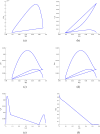Qualitative analysis and chaotic behavior of respiratory syncytial virus infection in human with fractional operator
- PMID: 38272984
- PMCID: PMC11224310
- DOI: 10.1038/s41598-023-51121-0
Qualitative analysis and chaotic behavior of respiratory syncytial virus infection in human with fractional operator
Erratum in
-
Author Correction: Qualitative analysis and chaotic behavior of respiratory syncytial virus infection in human with fractional operator.Sci Rep. 2024 Feb 13;14(1):3633. doi: 10.1038/s41598-024-54130-9. Sci Rep. 2024. PMID: 38351207 Free PMC article. No abstract available.
Abstract
Respiratory syncytial virus (RSV) is the cause of lung infection, nose, throat, and breathing issues in a population of constant humans with super-spreading infected dynamics transmission in society. This research emphasizes on examining a sustainable fractional derivative-based approach to the dynamics of this infectious disease. We proposed a fractional order to establish a set of fractional differential equations (FDEs) for the time-fractional order RSV model. The equilibrium analysis confirmed the existence and uniqueness of our proposed model solution. Both sensitivity and qualitative analysis were employed to study the fractional order. We explored the Ulam-Hyres stability of the model through functional analysis theory. To study the influence of the fractional operator and illustrate the societal implications of RSV, we employed a two-step Lagrange polynomial represented in the generalized form of the Power-Law kernel. Also, the fractional order RSV model is demonstrated with chaotic behaviors which shows the trajectory path in a stable region of the compartments. Such a study will aid in the understanding of RSV behavior and the development of prevention strategies for those who are affected. Our numerical simulations show that fractional order dynamic modeling is an excellent and suitable mathematical modeling technique for creating and researching infectious disease models.
© 2024. The Author(s).
Conflict of interest statement
The authors declare no competing interests.
Figures






Similar articles
-
A mathematical fractal-fractional model to control tuberculosis prevalence with sensitivity, stability, and simulation under feasible circumstances.Comput Biol Med. 2024 Aug;178:108756. doi: 10.1016/j.compbiomed.2024.108756. Epub 2024 Jun 19. Comput Biol Med. 2024. PMID: 38901190
-
Wavelet Collocation Method for HIV-1/HTLV-I Co-Infection Model Using Hermite Polynomial.Adv Biol (Weinh). 2024 Oct;8(10):e2300629. doi: 10.1002/adbi.202300629. Epub 2024 Aug 9. Adv Biol (Weinh). 2024. PMID: 39123297
-
Dynamics of chaotic system based on circuit design with Ulam stability through fractal-fractional derivative with power law kernel.Sci Rep. 2023 Mar 28;13(1):5043. doi: 10.1038/s41598-023-32099-1. Sci Rep. 2023. PMID: 36977727 Free PMC article.
-
Nirsevimab for the prevention of respiratory syncytial virus disease in children. Statement of the Spanish Society of Paediatric Infectious Disease (SEIP).An Pediatr (Engl Ed). 2023 Oct;99(4):257-263. doi: 10.1016/j.anpede.2023.09.006. Epub 2023 Sep 22. An Pediatr (Engl Ed). 2023. PMID: 37743207 Review.
-
Use of mathematical modelling to assess respiratory syncytial virus epidemiology and interventions: a literature review.J Math Biol. 2022 Feb 26;84(4):26. doi: 10.1007/s00285-021-01706-y. J Math Biol. 2022. PMID: 35218424 Free PMC article. Review.
Cited by
-
Modeling and analysis using piecewise hybrid fractional operator in time scale measure for ebola virus epidemics under Mittag-Leffler kernel.Sci Rep. 2024 Oct 23;14(1):24963. doi: 10.1038/s41598-024-75644-2. Sci Rep. 2024. PMID: 39443508 Free PMC article.
References
-
- Arenas AJ, González G, Jódar L. Existence of periodic solutions in a model of respiratory syncytial virus RSV. J. Math. Anal. Appl. 2008;344(2):969–980. doi: 10.1016/j.jmaa.2008.03.049. - DOI
-
- Glezen WP, Taber LH, Frank AL, Kasel JA. Risk of primary infection and reinfection with respiratory syncytial virus. Am. J. Dis. Child. 1986;140(6):543–546. - PubMed
-
- Rao F, Mandal PS, Kang Y. Complicated endemics of an SIRS model with a generalized incidence under preventive vaccination and treatment controls. Appl. Math. Model. 2019;67:38–61. doi: 10.1016/j.apm.2018.10.016. - DOI
-
- Lin J, Xu R, Tian X. Global dynamics of an age-structured cholera model with both human-to-human and environment-to-human transmissions and saturation incidence. Appl. Math. Model. 2018;63:688–708. doi: 10.1016/j.apm.2018.07.013. - DOI
MeSH terms
LinkOut - more resources
Full Text Sources
Medical

